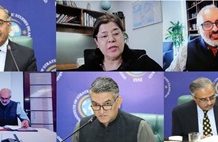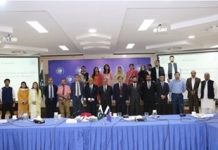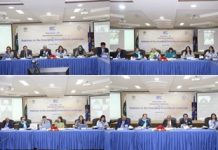We do not have a clear answer to our first question, but what we can see over the political horizon are two words in bold print: instability, uncertainty
This is a question on the mind of every Pakistani today; it is also being debated in the western academic and policymaking circles. Tagged with it are several other questions: how will Musharraf leave the political scene that he has dominated for the last seven-and-half years; will there be a lot of bloodshed in the streets of our cities, replays of the May 12 carnage in Karachi, before he decides to quit; will the evolving anti-regime movement, in its drive to restore democracy, cripple the state and make it dysfunctional; how big and blinding a political storm can we expect in the coming days?
There are no definite answers to any of these questions but the fact that they are being asked, debated and speculated upon suggests that a sense of political uncertainty about the regime prevails in the country. Nobody raised these questions before March 9, at least not seriously; rather, political parties and the civil society have looked forward to the general election at the end of the year. What has followed the filing of the reference against the chief justice has shaken the very foundations of the military regime and its allies.
President Musharraf had many good opportunities to correct the mistakes and make prudent and intelligent moves to recapture the political initiative but he lost them. It seems that he has also missed the reconciliation bus and fallen back on his professional instincts in deciding to fight back with whatever political weapons are left in his arsenal.
The emerging confrontation between the military regime and the political opposition is not in the best interests of the country, but it is real and it is happening. We have two visible political camps, one led by the commander-in-chief of the armed forces and the other by a multi-layered and multi-dimensional political opposition. The battle lines are drawn and fire being exchanged. The tragic events of Karachi show the two sides can resort to murder as well.
We have a historical record of political agitations slipping into open warfare. Political groups and regimes in the past have target-killed opponents an old feudal practice. And our tradition of non-violent resistance both in our political thought and practice is weaker than many other nations.
The spectre of violence does not bode well for a country that is facing multiple internal and external threats. Our internal vulnerabilities accumulated over a longer period of autocratic regimes are too many and too complex to be handled effectively by military regimes. We must know that there will be no winners in the end if political agitation turns violent and the regime and its allies resort to the tactics of May 12.
What are the relative strengths, weaknesses and the capacities of the two sides in the emerging political confrontation? The c-in-c camp has lost a number of its political assets. The public or the outside world no longer sees it as clean, honest and committed to doing better than its predecessors. Unconstitutional regimes derive their legitimacy, if they care about it, from performance in improving governance, delivering better services and ending corruption. On these counts the present regime has miserably failed. A number of scandals, Pakistan Steel Mills and Karachi Stock Exchange crash just being the most visible ones, have exposed the hollow claims of honesty and integrity of high public holders. “Who is not corrupt” has become a common catch phrase to defend individual corruption.
The loss of hope to bring structural reforms in vital sectors of the state and society and pave the way for democracy and constitutionalism has faded from the present regime; its credibility is also irreparably damaged. Even those are no longer on his side who did not protest against his initial constitutional deviations in the hope that Musharraf might put the country back on normal political track after conducting accountability and arranging free and fair elections.
The fraudulent referendum and later the disfiguration of the constitution through the 17th Amendment should have provoked mass resistance, but it did not. The MMA sold its soul like many other parties in Parliament that have historically been committed to the restoration of the 1973 Constitution in its original form and spirit. The other factors were political passivity and lack of trust in the mainstream political parties that danced like helpless puppets in the hands of invisible forces and their autocratic leaders.
What is left in the political store of Musharraf: a tainted MQM with a withering support base, a fragmented PMLQ and some members of the feudal class, who change parties and sides at the drop of a hat? Musharraf’s is the only strident voice defending himself, his record and his political vision. His strong crowd of supporters has gradually disappeared from the public scene; they are quite reluctant to stand up and speak for him. They can see the ship foundering on the rocks.
The political movement is at its early stages. But it is vigorous, and there is a remarkable sense of consensus on parliamentary democracy and rule of law among all the players that are joining its ranks. It started with lawyers’ outrage over a fundamental national issue, the independence of judiciary. All opposition groups, civil society actors, media and now other professional groups and associations have gradually singed up for regular protests in major cities. They have political initiatives and rallied support around the poor record of governance, poverty, corruption, the subordination of legislatures and the assault on judiciary. If these were not enough, allowing slaughter to happen in Karachi, caught on camera, has added greatly to the political ammunition of the opposition.
Against so many odds, Musharraf is very keen to retain power. He may seek some reassurance in his natural constituency, the Army. Instinctively he would take refuge in the uniform, which he has aptly declared his “second skin”. Musharraf has been exploring alternative to this “second skin” to ensure his political survival; one tactic was the attempt to strike a deal with the Pakistan People’s Party, more appropriately with its leader Benazir Bhutto. There are quite a few signs of this happening and accountability cases and sharing power likely to be exchanged for supporting Musharraf for his election. If the deal materialises, the opposition in the absence of the PPP will be weakened.
This may seem unlikely and unnatural, but politics does force one to take on strange bedfellows when interests coincide. But such marriages of convenience do not last very long. If the PPP gets its wish of forcing Musharraf to doff uniform, the dynamics of Pakistani politics will change because of fresh political polarisations.
The fact is that the events of the last ten weeks have greatly diminished the usefulness of PPP’s partnership with Musharraf. We do not have a clear answer to our first question, but what we can see over the political horizon are two words in bold print: instability, uncertainty.
The author is a professor of Political Science at the Lahore University of Management Sciences.












